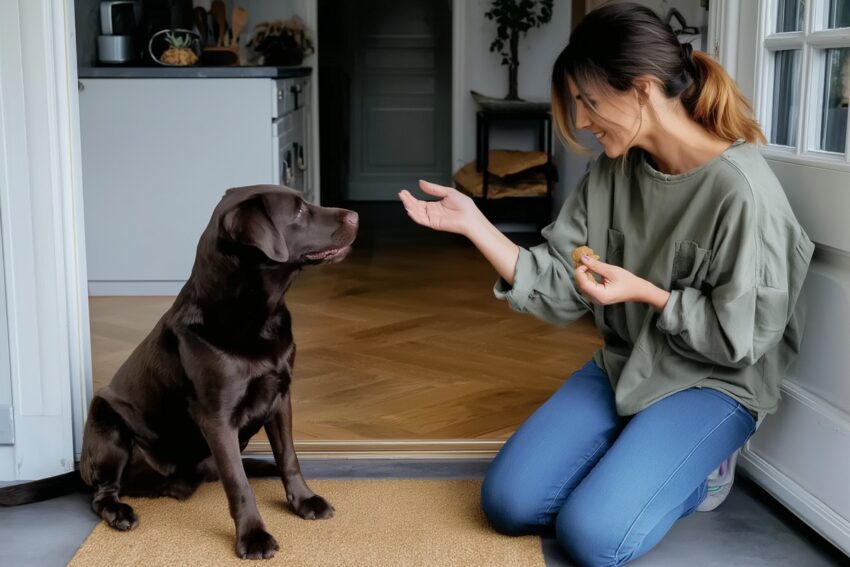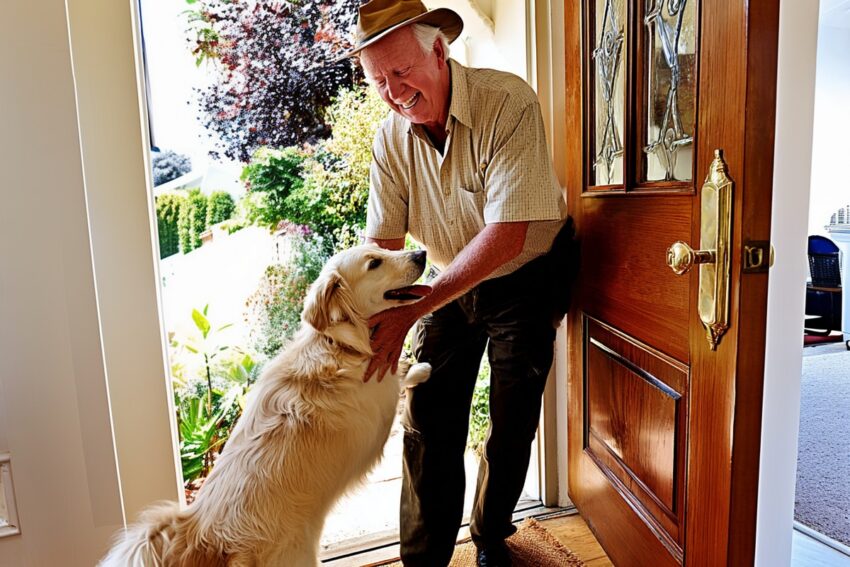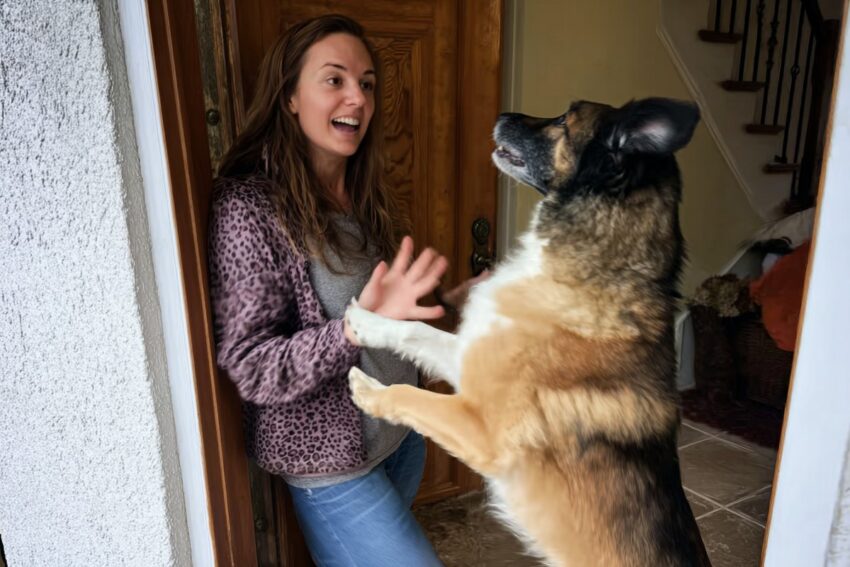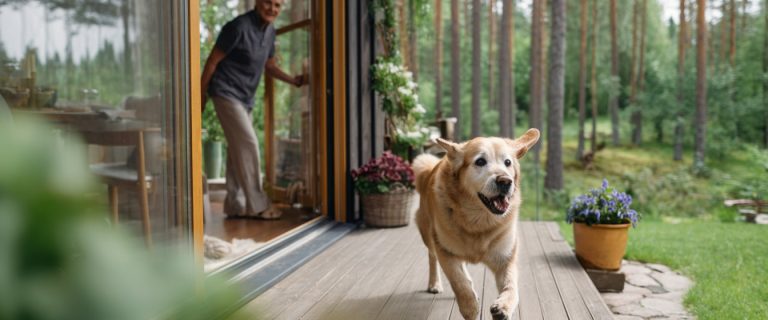Every time the doorbell rings, your dog morphs into a furry missile—jumping, barking, maybe even bolting outside. Sound familiar?
If you’re wondering how to train your dog to greet visitors without turning your home into a circus, you’re in the right place.
We’ve been there—embarrassed, frustrated, and maybe even a little worried someone’s going to get knocked over. But with a little prep and the right training plan, calm hellos are totally possible.
Let’s walk through it together.
🐾 TL;DR — Calm Hellos Start with Simple Training
- 🔊 Dogs go wild at the door from instinct—not bad manners.
- 🛎 Start by desensitizing them to the doorbell or knock sounds.
- 📍 Teach a specific “greeting spot” where they sit when someone arrives.
- 👫 Practice with one familiar guest before moving to group greetings.
- 🎯 Stay consistent and reward calm behavior—not just cute antics.
Keep scrolling for step-by-step guidance, bonus tips, and real-life training hacks that actually work.
Treats + praise = success faster and happier.
Train when your dog is calm—not overhyped.
Consistency teaches faster than corrections.
Why Dogs Go Bonkers at the Door
Let’s get real: your dog isn’t trying to embarrass you. They’re just… being a dog.
That wild, barking, tail-wagging chaos when someone shows up? It’s rooted in instinct, excitement, and lack of structure—not misbehavior. Understanding why they react this way is the first step toward changing it.
Here’s what’s really going on:
- Territorial instincts kick in the second they hear a knock or bell. Your dog sees the door as a boundary—and they’re on alert to protect it.
- Pent-up energy often explodes the moment a “trigger” appears. If your dog’s been cooped up or bored, a guest = instant outlet.
- Inconsistent rules confuse them. One person allows jumping. Another scolds. Some pet them mid-chaos. No wonder they’re unsure what to do.
💡 Pro Tip: Dogs want structure. When you give them a consistent, rewarding routine for greetings, most of that wild behavior fades fast.
Hot Tip:

Prep Like a Pro: What You’ll Need Before You Start
Before we dive into the step-by-step training, let’s make sure you’ve got your tools (and your mindset) ready. You don’t need much—but these few things will make a huge difference.
What You’ll Need:
- Training treats — Small, tasty rewards that keep your pup motivated.
- A leash — Essential for the early practice rounds.
- A patient partner — Someone to act as the “guest” for training (trust us, you’ll need them by Step 3!).
What You Need to Know:
- Start with basic commands — Make sure your dog knows how to sit, stay, and follow a quiet cue. If you need a refresher, check out our guide on how to teach your dog to sit.
- Patience isn’t optional—it’s everything — Dogs feel your energy. If you’re tense, they’ll be tense. Pick calm, low-stress times for training.
- Timing is powerful — Train when your dog is relaxed and not super hyped. Evenings after dinner work well for many pups.
- Consistency wins — The biggest training secret? Do the same thing every time. No treats for jumping “just this once.” It sends mixed messages.
- Limit distractions early on — Choose a quiet training zone for now. You’ll add distractions later once your dog’s got the hang of it.
Gear Tip: Treat Pouch + Clicker Combo
Want smoother, faster progress? A treat pouch + clicker combo gives you two of the most powerful training tools in one.
The pouch keeps rewards handy so you never miss a good moment, and the clicker helps your dog understand exactly what they’re being praised for—especially during sit, stay, and quiet commands.
HIGH-CAPACITY & HANDS-FREE – This large dog treat pouch holds more treats, toys, and even tennis balls than most, with a built-in poop bag holder for quick clean-ups. Multiple wearing options (shoulder strap, waist belt, or clip) keep you comfortable and hands-free. Includes two training clickers, roomy storage for personal items, and a durable, easy-to-clean nylon design—perfect for training sessions at the park or on the go.
Step 1: Mute the Madness
(Desensitize Your Dog to the Doorbell or Knock)

For most dogs, the chaos starts before anyone even walks in—usually the second that doorbell rings or someone knocks. Even TV doorbells can send them into a tailspin. Sound familiar?
Let’s fix that.
Here’s how to desensitize your dog to the door-trigger frenzy:
Step-by-Step Training
- Start on-leash. Clip your dog’s leash and ask your partner to ring the bell or knock while you’re both inside.
- Interrupt the outburst gently. The moment your dog barks or jumps, give a calm cue like “Quiet” or “No bark.” Don’t yell. Stay calm.
- Reward the calm. As soon as your pup stops barking—even for a beat—praise them and offer a treat.
- Add structure. Once they’re quiet, ask them to sit. Reward again.
- Repeat. A lot. It may take dozens of tries over multiple days. That’s normal. Once your dog is handling this on-leash, try off-leash with supervision.
💡 Pro Tip: Want to reduce triggers while you’re training? Stick a cute “Please don’t ring—dog in training” sign on your door. Trust us, it saves your sanity.
Step 2: Master the Greeting Spot
(Teach Your Dog Where to Sit When Guests Arrive)

Now that your dog isn’t flipping out over the doorbell, it’s time to give them a job: sitting calmly in a designated spot when someone enters.
This simple trick changes everything—it shifts their mindset from “chaotic greeter” to “calm watcher.”
How to Create a Greeting Spot Routine:
- Pick the location. Choose a calm spot near the door but out of the traffic zone. A small rug or mat helps visually anchor it.
- Leave, then come back. Yep—you’re the “guest” first. Step outside, wait 30–60 seconds, and re-enter like you’re arriving.
- Ignore the hype. When your dog runs up or jumps, resist the urge to engage. No eye contact, no touch, no voice.
- Wait them out. As soon as they pause or back off, calmly walk to the greeting spot and cue “sit.”
- Reward calm behavior in the spot. Treats, praise, affection—give it all once they’re sitting in the right place.
- Repeat until it becomes muscle memory. Do short, frequent sessions throughout the week to lock it in.
💡 Pro Tip: Dogs love clear boundaries. Use a phrase like “go to your mat” or “door spot” consistently so they connect the cue with the behavior.
Want a deeper dive into sit training basics? Don’t miss our post on how to teach your dog to sit.
Step 3: Practice with Friendly Faces
(Start Controlled Guest Training)
Once your dog has nailed sitting calmly when you enter, it’s time to raise the stakes—bring in a real person.
Start slow. This isn’t a dinner party. It’s a practice run.
Here’s How to Do It:
- Pick your “dog-friendly” friend. Choose someone patient who won’t mind being ignored by your pup for a bit.
- Set up the scene. Leash your dog and position them in their “greeting spot” before the knock or ring happens.
- Guest arrives, dog stays. When the guest enters, your job is to make sure your dog stays in place. Gently block or guide back if needed—no harsh corrections.
- Ignore first, reward second. Have your guest completely ignore your dog until they’re sitting calmly. Then—and only then—can the guest say hello with your permission and offer a treat.
- Keep it short. After a minute or two, release your dog with a cue like “Okay, say hi!” Let them greet politely, then encourage them to settle elsewhere as the visit continues.
⚠ Heads-up: If your dog gets overly excited or fearful, dial it back. Go back to practicing just with you until they’re calm and confident.
Step 4: Add More Humans
(Gradually Increase the Group Size)
Your dog has mastered one-on-one greetings? Amazing. Now it’s time to level up—but slowly.
Throwing them into a crowded room too soon is a recipe for relapse. This stage is all about controlled exposure to small groups.
How to Train for Group Greetings:
- Start with 2–3 people max. Pick guests who get dogs and won’t encourage jumping or hype. Calm energy only.
- Repeat the routine. Just like Step 3—leash on, dog in greeting spot, doorbell rings, calm sits = reward.
- Use spaced-out entrances. Have guests come in one at a time instead of all at once. It reduces overwhelm and gives your dog multiple chances to practice.
- Allow short greetings—then settle. After your pup greets calmly, guide them to another room or a comfy bed. Visits shouldn’t revolve around your dog 100% of the time.
- Praise progress, even if it’s small. Every guest who walks through the door without chaos is a win. Celebrate it with treats, love, and maybe a little happy dance.
Real Talk Reminder: This step may take a few weeks or even longer, depending on your dog’s temperament and history. That’s totally okay.
Step 5: Celebrate Progress & Be Patient
(Training Takes Time—And That’s Okay)

Let’s be honest—teaching your dog to greet visitors calmly isn’t a one-week thing. It’s a journey. But one that’s so worth it.
There will be days they totally nail it… and days they regress and tackle Grandma like a linebacker. Breathe. That’s part of the process.
Here’s What to Keep in Mind:
- Consistency beats perfection. Don’t stress over one “oops” moment. Keep doing the routine. It will click.
- Avoid punishment. Correct calmly. But don’t scold, isolate, or yell. Fear-based responses break trust.
- Notice the wins. Did your dog bark less this time? Sit for two seconds longer? That’s growth. Celebrate it!
- Check your energy. If you’re tense or annoyed, your dog will feel it. Stay calm. Smile. You’ve got this.
💡 Pro Tip: Film your sessions once a week. It helps you track progress and reminds you how far you’ve come when you’re in the thick of it.
Bonus: How to Reinforce Calm Greetings Long-Term
(Because Good Habits Need Maintenance)
You did it. Your dog no longer acts like a furry hurricane when someone comes over. 🎉 Now comes the part people forget: maintenance. Without it, old habits creep back in.
The good news? Keeping calm greetings strong takes just a little consistency and a few smart habits.
Keep It Going With These Quick Wins:
- Keep rewarding calm—even randomly. Surprise reinforcement keeps your dog engaged. Toss a treat when they choose to stay in their spot without being asked.
- Don’t let guests undo your work. We love Aunt Cathy, but if she hypes your dog up every time she visits, have a quick chat. Calm hellos only.
- Mix it up to keep things fresh. Try having guests enter through different doors, or practice at random times. It prevents your dog from getting too routine-dependent.
- Revisit training every few weeks. Short, refresh sessions keep the behavior sharp and your dog confident.
⚠️ Heads-up: Dogs go through “regression stages,” especially during adolescence. It’s normal. Just go back to earlier steps when needed—it’s not failure, it’s reinforcement.
You’re Building a Calmer, Happier Home—One Hello at a Time
If you’ve made it this far, give yourself a moment to be proud. Teaching your dog how to greet visitors nicely isn’t just about behavior—it’s about creating peace, structure, and joy in your home.
Every treat, every sit cue, every patient moment—it’s all building a bond based on trust.
And that wild greeter you started with? They’re learning how to be calm, confident, and ready for any visitor.
Keep the Progress Going
Author
-
Hey there, I'm Jamey, and I've been an animal lover for as long as I can remember. Growing up on a 50-acre farm in Ontario, Canada, I was surrounded by a menagerie of furry friends, from beloved cats and dogs to goats, horses, cows, and even chickens. Now, I call Victoria, British Columbia my home, and my heart belongs to my adorable Balinese cat, Milo. When I'm not editing blog posts here at DogVills, I enjoy helping solo entrepreneurs with their passion projects and online marketing. Over the years, I've also ventured into creating and selling various blogs.
View all posts




